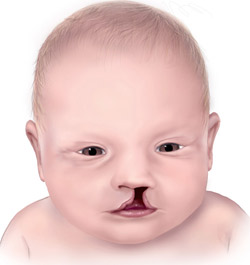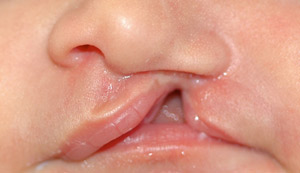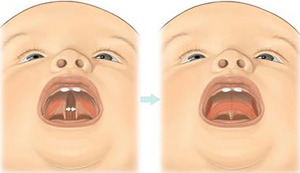
Cleft lip is a split that develops in the lip between the central portion (philtrum) and the side of the lip. This split may be only a small notch or a complete separation of the lip segments or anything in between, in its complete manifestation the split will also involves the gums( alveolus) and the front part of the palate(roof of the mouth). Nasal deformity is present and its involvement is in proportion to the lip deformity. The condition may occur on one side or both sides. When only one side is involved this deformity is more common on the left side.
Advanced: The philtral ridge (see section on medical terminology) on the cleft side of the lip is absent and lip on that side is smaller as compared to the other side. The cupids bow ( see section on medical terminology) is tilted upwards on the cleft side and will be inadequately developed on the cleft side. The upper jaw may be deficient on the cleft side while the central portion of the jaw may be turned forwardly when complete deformity is present. The nasal deformity besides the external visible deformities involves presence of deviated nasal septum or DNS (deformity of the structure separating the both nostrils) which leads to breathing difficulty.

When the cleft lip is present on both sides the central portion of the lip and upper jaw is free from any attachments on both sides, this leads to unhindered growth of this segment which is also called premaxilla. In these patients premaxilla and the central lip protrude significantly on front and thus making its subsequent surgery more difficult. This condition needs to be treated early in life vigorously (see section titled ‘soon after birth’)

Cleft of roof of the mouth (palate) begins from the part in the back which hangs in the throat and is called uvula, it can be a small notch or can extend all the way to the front stopping short of the gums. Sometimes there is just a notch or a normal looking palate with failure of muscle development, this condition is called submucous cleft palate.
Advanced: Muscles in the palate are located in the back part which is soft and is called the soft palate as compared to the front which is supported by bone and is called the hard palate( ). These muscles help close the nasal airways from the mouth during speech. Failure of these muscles to recover complete function after repair leads to nasal tinge to the speech. In some cases the speech is so bad that it becomes incomprehensible ( ). Modern day repair lays special emphasis on repair of these muscles. In addition these muscles are also important for swallowing as a result nutritional deficiencies are common (feeding advise).
Submucous cleft is a cleft where the palate is united but the muscles inside palate are not. Mostly it is represented as a groove in the centre and a small split in the uvula (tip of the palate that hangs into the throat. Submucous cleft is often missed as a diagnosis in early childhood. Some of these children will develop normal speech while others will need surgical intervention.